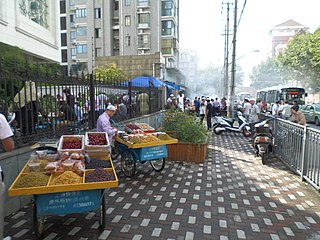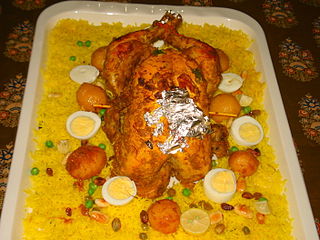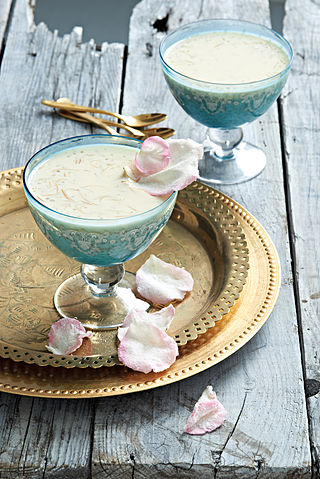
Pakistani cuisine can be characterised as a vibrant blend of regional cooking styles and flavours from across South, Central and Western Asia, as well as ingredients, recipes and techniques borrowed from the Indian Subcontinent, Persian cuisine and Arab cuisine. The cuisine of Pakistan also maintains certain Mughal influences within its recipes and techniques. The country's various cuisines are varied from place to place, with its ethnic and cultural diversity, as well as diverse climates and geographical environments, and availability of different produce options.

Bengali cuisine is the culinary style of Bengal, that comprises Bangladesh and the Indian states of West Bengal and Tripura. The cuisine has been shaped by the region's diverse history and climate. It is known for its varied use of flavours including mustard oil, as well as the spread of its confectioneries and desserts. There is a strong emphasis on rice as a staple, with fish traditionally the most common protein. Freshwater fish are preferred to seafish, although barramundi, known as bhetki, is also common. Meat is also a common protein among Bengalis with beef and goat meat being the most popular. In more recent times, lentils have begun to form a significant part of the diet. Many Bengali food traditions draw from social activities, such as adda, or the Mezban.

Gulab jamun is a sweet confectionery or dessert, originating in Persia and then later introduced to the Indian subcontinent. It is popular in India, Pakistan as well as Myanmar. It is also common in nations with substantial populations of people with South Asian heritage, such as Mauritius, Fiji, Gulf states, the Malay Peninsula, Great Britain, South Africa, and the Caribbean countries of Trinidad and Tobago, Guyana, Suriname, and Jamaica.

Jalebi is a popular sweet snack in South Asia, Middle East, Africa, and Mauritius. It goes by many names, including jilapi, zelepi, jilebi, jilipi, zulbia, jerry, mushabak, z’labia, zengoula or zalabia.

Double ka meetha (also known as Shahi Tukra, is an Indian bread pudding sweet made of fried bread slices soaked in hot milk with spices, including saffron and cardamom. Double ka meetha is a dessert of Hyderabad. It is popular in Hyderabadi cuisine, served at weddings and parties. Double ka meetha refers to the milk bread, called "double roti" in the local Indian dialects because it swells up to almost double its original size after baking.

A falooda is a Mughlai cuisine version of a cold dessert made with noodles. It has origins in the Persian dish faloodeh, variants of which are found across West, Central, and South Asia. Traditionally it is made by mixing rose syrup, vermicelli, and sweet basil seeds with milk, often served with ice cream. The vermicelli used for preparing falooda is made from wheat, arrowroot, cornstarch, or sago.

Hyderabadi biryani is a style of biryani originating from Hyderabad, India made with basmati rice and meat. Originating in the kitchens of the Nizam of Hyderabad, it combines elements of Hyderabadi and Mughlai cuisines. Hyderabad biryani is a key dish in Hyderabadi cuisine and it is so famous that the dish is considered synonymous with the city of Hyderabad.

Cuisine of the Indian subcontinent includes the cuisines from the Indian subcontinent comprising the traditional cuisines from Bangladesh, Bhutan, India, the Maldives, Nepal, Pakistan and Sri Lanka.

Bangladeshi cuisine is the national cuisine of Bangladesh. It has been shaped by the region's history and river-line geography. The country has a tropical monsoon climate. The staple of Bangladesh is rice and fish. The majority of Bangladeshi people are ethnic Bengali, accustomed to Bengali cuisine, with a minority of non-Bengalis, many used to cuisines from different traditions and regions. Bangladeshi cooking features more meat dishes than the cuisine of neighbouring West Bengal, India.

Sindhi cuisine refers to the distinct native cuisine of the Sindhi people from Sindh, Pakistan. Sindhi cuisine has been influenced by Central Asian, Iranian, Mughal food traditions. It is mostly a non-vegetarian cuisine, with even Sindhi Hindus widely accepting of meat consumption. The daily food in most Sindhi households consists of wheat-based flat-bread (phulka) and rice accompanied by two dishes, one gravy and one dry with curd, papad or pickle. Freshwater fish and a wide variety of vegetables are usually used in Sindhi cuisine. Restaurants specializing in Sindhi cuisine are rare, although it is found at truck stops in rural areas of Sindh province, and in a few restaurants in urban Sindh.

Hyderabadi cuisine, also known as Deccani cuisine, is the native cooking style of the Hyderabad, Telangana, India. The haute cuisine of Hyderabad began to develop after the foundation of the Bahmani Sultanate, and the Qutb Shahi dynasty centered in the city of Hyderabad promoted the native cuisine along with their own. Hyderabadi cuisine had become a princely legacy of the Nizams of Hyderabad as it began to further develop under their patronage.

Sheer khurma or sheer khorma is a festival vermicelli pudding prepared by Muslims on Eid ul-Fitr and Eid al-Adha in India,Pakistan, Afghanistan, and parts of Central Asia. It is equivalent to shemai, a Bangladeshi dessert. It is a traditional Muslim festive breakfast, and a dessert for celebrations. This dish is made from various dry fruits, vermicelli, condensed milk, sugar etc. Depending on the region, cardamom, pistachios, almonds, cloves, saffron, raisins, and rose water are also added.

Mughlai cuisine consists of dishes developed or popularised in the medieval Indo-Persian cultural centres of the Mughal Empire. It represents a combination of cuisine of the Indian subcontinent with the cooking styles and recipes of Central Asian and Islamic cuisine. Mughlai cuisine is strongly influenced by the Turkic cuisine of Central Asia, the region where the early Mughal emperors originally hailed from, and it has in turn also influenced the regional cuisines of Northern India, Pakistan and Bangladesh to little extent.

Watalappam is a coconut custard pudding made of coconut milk or condensed milk, jaggery, cashew nuts, eggs, various spices, including cardamom, cloves, and nutmeg, and sometimes thick pandan juice or grated vanilla pods.
Awadhi cuisine is a cuisine native to the Awadh region in Northern India. The cooking patterns of Lucknow are similar to those of Central Asia, the Middle East, and Northern India and western India with the cuisine comprising both vegetarian and non-vegetarian dishes. The Awadh region has been influenced by Mughal cooking techniques, and the cuisine of Lucknow bears similarities to those of Central Asia, Kashmir, Punjab and Hyderabad. The city is also known for its Nawabi foods.

Both festivals of Eid celebrated in the Muslim world include cuisines specific to countries and localities.

Gajar ka halwa, also known as gajorer halua, gajrela, gajar pak, and carrot halwa is a carrot-based sweet dessert pudding made by placing grated carrots in a pot containing a specific amount of water, milk and sugar, cardamom and then cooking while stirring regularly. It is often served with a garnish of almonds and pistachios. The nuts and other items used are first sautéed in ghee, a type of clarified butter from the Indian subcontinent.

Murgh musallam is a Mughlai dish originating from the Indian subcontinent. It consists of whole chicken marinated in a ginger-garlic paste, stuffed with boiled eggs and seasoned with spices like saffron, cinnamon, cloves, poppy seeds, cardamom and chilli. It is cooked dry or in sauce, and decorated with almonds and silver leaves.

Mughlai paratha is a popular Bengali street food consisting of a flatbread (paratha) wrapped around or stuffed with keema and or egg. It is believed to have originated in Bengal Subah during the time of Mughal Empire as a derivative of the Turkish Gözleme. The dish is believed to be prepared for the royal court of Mughal Emperor Jahangir.

Boeber is the Cape Malay name for a South African pudding. It has become a traditional Cape Malay sweet, milk drink, made with vermicelli, sago, sugar, and flavoured with cardamom, stick cinnamon, and rose water. The pudding is traditionally served on the 15th night of Ramadan to celebrate the middle of the fast, for those who have completed the first 15 days of fasting. They are also known as people who are op die berg.


















